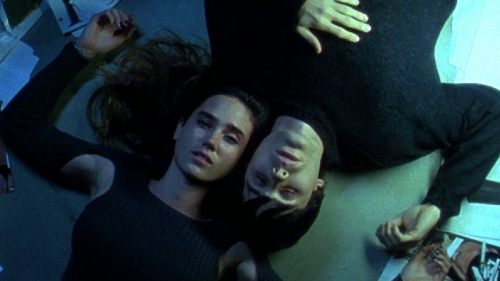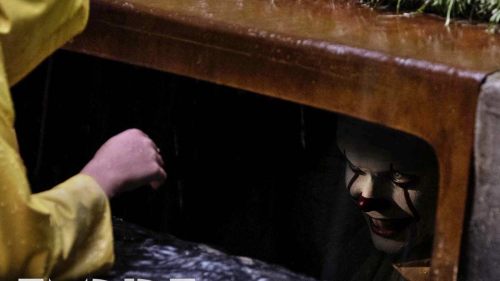PI: Finding Order In Chaos 20 Years Later
“There’s a beauty to Pi that keeps us looking at it...the digits of Pi are extremely random. They have no pattern, and in mathematics that’s really the same as saying they have every pattern.” --mathematician Jonathan Borwein
“11:15, restate my assumptions:
1. Mathematics is the language of nature.
2. Everything around us can be represented and understood
through numbers.
3. If you graph these numbers, patterns emerge.
Therefore: There are patterns everywhere in nature.” -- Max Cohen, Pi
Mathematics is considered to be a universal language due to the fact that its principles and theories are the same regardless of culture, religion, or gender. Galileo Galilei, Italian philosopher and mathematician, theorized that nature is written in mathematical language. Natural patterns including spirals, tessellations, and waves can present themselves in the smallest of particles in a plant to the vast organization of our solar system. Pi, or 3.14, is an irrational number originally defined as the ratio of a circle’s circumference to its diameter. Its decimal representation never ends and never truly settles into a permanent repeating pattern. Writer/director Darren Aronofsky explores the mysterious significance behind this mathematical constant in his directorial debut, Pi. Chaos theory is used as a plot point by focusing on the assumption that within the apparent randomness of complex chaotic systems, there are underlying patterns, feedback loops, self-organization, and repetition. While navigating a narrative based on the ubiquitous patterns in nature, Aronofsky simultaneously created his own pattern--an artistic method that delicately mutates in various ways throughout his film career through recurring themes, collaborations, and a signature technical style.
Pi chronicles the story of Maximillian Cohen (Sean Gullette), an introverted number theorist who suffers from cluster headaches and social anxiety. While Max is programming his computer, a seemingly random 216-digit-long number prints out which later syncs up to the financial pages in the daily paper. Discussing the occurrence with Sol (Mark Margolis), his mathematics mentor, fuels Max’s infatuation with searching for a pattern and deeper meaning behind the thread of these particular digits. A swirl of cream in a cup of black coffee; wind blowing through the trees; and birds migrating across the sky taunt Max as he examines the micro and macro significance of number theory while continuously stating three assumptions, thus yielding a conclusion that there are patterns everywhere in nature from biology, statistics, to religion. With this anchored in his psyche, Max aims to uncover a mathematical formula within the stock market-- the ultimate sea of numbers that dictates the global economy--a concept many are still intrigued by to this day.
Paranoia seeps in as Max encounters individuals aware of his endeavors. An unreliable narrator, his interactions question the nature of his reality as he spirals deeper into his obsessive conquest. Lenny, a member of a Hasidic sect, strikes up a conversation with Max at a local diner by explaining the mathematical symbolism within the Torah. He breaks down Gematria, a system with a numerical value assigned to each name or word. The conversation calls to mind the Fibonacci sequence and the Golden Ratio, which occurs if two quantities’ ratio is the same as the ratio of their sum to the larger of the two quantities. Its presence can be found in everything from a flower, a human body, hurricane patterns, and spiral galaxies.
Lenny is convinced the 216 digit number is associated with the language of God, meant for those in his synagogue to bring about the messianic age. Additionally, nefarious Wall Street agents are after Max’s knowledge. Both Lenny and these agents are representative of the spiritual and physical themes by personifying the central struggle of the film--a battle to find meaning in the religious unknown and the order within chaos of the stock market. Fixated on number sequences, patterns, and paranoia, Max sinks into a phantasmagoric nightmare saturated with Lynchian hallucinations. Unable to trust himself and those around him, he finally breaks, and in a climactic drill scene he sacrifices a small part of himself to obtain peace while a a pattern resembling a bifurcation diagram is apparent on his shattered mirror.
For his debut film, Aronofsky utilizes a combination of creativity and logic to explore themes that appear in other movies that span his extensive career. When creating Pi, the notion of a film centering around math with heavy sci-fi influences from the Japanese surreal film Tetsuo could have been considered risky. In order to construct art to appeal to an audience predominantly left-brained-- concerned with logic, math, and science-- Aronofsky faced the challenge of building an analytical storyline told through a right-brain, imaginative and experimental approach to capture viewers through rhythmic pacing and the visualization of feelings such as paranoia and fixation. Meant to be shot from a subjective perspective, the camera focuses on Max primarily in profile, whereas those seeking his knowledge are shot with a more straight-forward point of view, thus allowing the audience to see Max’s reality more subjectively. Due to a low budget, Pi is shot on high contrast black-and-white reversal film with the idea of Frank Miller’s Sin City serving as inspiration. In order to convey the heightened intensity of Max’s attention to detail and subsequent psychosis, close-up shots become a reliable method. Repetitive close-up scenes of pills dropping into Max’s hand, locks shifting across the door, numbers in the newspaper, and scurrying ants emphasize desired detail in hopes of understanding and ultimately controlling chaos.
These sequences laid the foundation for a methodical approach to filmmaking for Aronofsky. Themes of seeking knowledge and perfection, addiction, control and lack thereof, are rooted in his storytelling. Aronofsky’s follow-up film, Requiem for a Dream is a highly stylized descent into drug addiction. His signature close-up shots continue in the same manner as Pi, and he utilizes split screen techniques to juxtapose control with detrimental urges and physical versus emotional attachment. While most ninety-minute films contain 600 to 700 cuts, Requiem contains 2,000. This editing choice enhances the chaotic nature of his addict protagonists while effectively immersing the audience in their depravity. His character-driven stories employ and subsequently demolish Maslow’s Hierarchy of Needs, exhibited by protagonists who are in desperate need of psychological help, but the desires they seek (knowledge, drugs, perfection, or defiance of death) are all sacrificed for their self-actualization, self-esteem, love, safety, and physiological health. Aronofsky’s psychological thriller Black Swan tells the story of a ballerina who starves and isolates herself by dancing around sanity in order to obtain the perfection of her craft. Similarly, in The Wrestler, the protagonist neglects his heart condition in order to continue striving towards athletic glory. The desire for control and avoidance of death as exhibited in The Fountain is conveyed in a dream-like state with graceful surrealism on par with the nightmare sequences of Black Swan and alluring hallucination shots in Requiem. Much like Pi, each of these films alternates between reality and a brooding landscape while following a character in search of a dream, yet haunted by their fears of failure, death, lack of control, and knowledge.
Along with the emergence of recurrent themes, Aronofsky also utilizes Pi to initiate a pattern of creative collaboration. Actor Mark Margolis has appeared in six of his films, while Jennifer Connelly and Sean Gullette have worked with Aronofsky repeatedly, as well. English composer Clint Mansell made his film score debut in Pi by providing menacing tracks with hypnotic electronica melodies that strongly hold up alongside other artists on the soundtrack such as Aphex Twin and Orbital. Mansell went on to score every other one of Aronofsky’s films except Mother!. His ability to fluctuate between nightmare and fantasy is exhibited through string instruments that sharply inject themselves into the veins of Requiem’s drug addicts, the religious delirium whispering God’s plan in Noah, the lyrically kinetic madness in Black Swan, and transcendental symphonies to defy death’s design in The Fountain.
Cerebral cinematographer Matthew Libatique is also an Aronofsky favorite. Known for shooting with a handheld camera, utilizing an anamorphic lens and capturing images’ natural light, Libatique tends to gravitate towards a soft look despite often painfully potent plotlines. He utilizes color as a differentiating factor to contrast actors from their background and from one another. His use of color-breaks typifies various characters by assigning them a prominent color in order to subtly convey emotion and smoothly transition scenes. To emphasize the subjective nature of Max’s story in Pi, Aronofsky and Libatique invented a number of different camera setups including a “Heat-Cam” that creates ripples in front of the lens, as well as a “Vibrator-Cam”, which is used for the violent, jarring effect to enhance Max’s peril.
The methodical and trademark style of Darren Aronofsky ultimately originated in his debut. Restricted as an up-and-coming filmmaker, he didn’t conform to convention and instead delivered his art full-throttle by bringing maladjusted characters to life within a storyline dense with topics such as religion, mathematics, and mental health--topics that could make veteran filmmakers apprehensive to address. Max states, “when I was a little kid my mother told me not to stare into the sun. So once when I was six, I did”. It’s this kind of artistic rebellion that sets Aronofsky aside from other filmmakers.
While Max was searching for a pattern in the stock market, Aronofsky could have simultaneously been seeking his own pattern in order to create stories told through a uniquely crafted lense--a style formed out of the chaos of an indie filmmaker on a minimal budget but rich in atypical ambition. Transforming his approach in a refreshing manner with each new project, Aronofsky’s signature style is solidified within Pi and thanks to this brash black-and-white gem, a mathematical approach transcended offscreen to propel his career into the trajectory that commands audiences to pay attention each time his name circulates in the cinematic scene.



